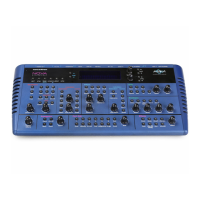Additionally there is a synthesis method called Oscillator sync. This takes two oscillators & uses one ( the Master ) to reset the
other ( The Slave ) each time it starts a new cycle. The effect is most noticeable when the two oscillators are out of tune as shown
below.
This Sync Effect creates very piercing & metallic sounds & are used a lot as lead sounds. It is worth noting that the Nova does not
require 2 oscillators to create this effect. The Sync “Effect” is created by the Analogue Sound Modelling process without the need
for a Sync Oscillator, there is merely a “Sync” parameter that creates the classic Sync Effect. This means that each of the 3 oscilla-
tors in one Nova “voice” can be independently Sync’ed as if there were 3 Master & 3 Slave oscillators.
Analogue Sound Modelling technology also enables the creation of some new “Sync” related parameters that are not found on
analogue synthesisers. These are “Key Sync”, “Sync Skew” & “Formant Width”
Normally in an analogue synthesiser even though the Master & Slave oscillators are detuned relative to each other, they both track
keyboard pitch equally. i.e. if you play notes one octave apart, both the Master & the Slave oscillator will be transposed one octave.
“Key Sync” allows the slave oscillator to have its pitch tracking adjusted independently. This means that the “Sync Effect” will
change as you play different notes up & down the keyboard.
Sync Skew manipulates the frequency of the “virtual” slave oscillator within one cycle of the master oscillator. As can be seen the effect is
the Sync Effect seems to have a higher frequency at the end of each cycle with positive modulation & at the start of the cycle with negative
modulation. This parameter makes the sync waveform sound even harsher. This is particularly good for aggressive lead sounds.

